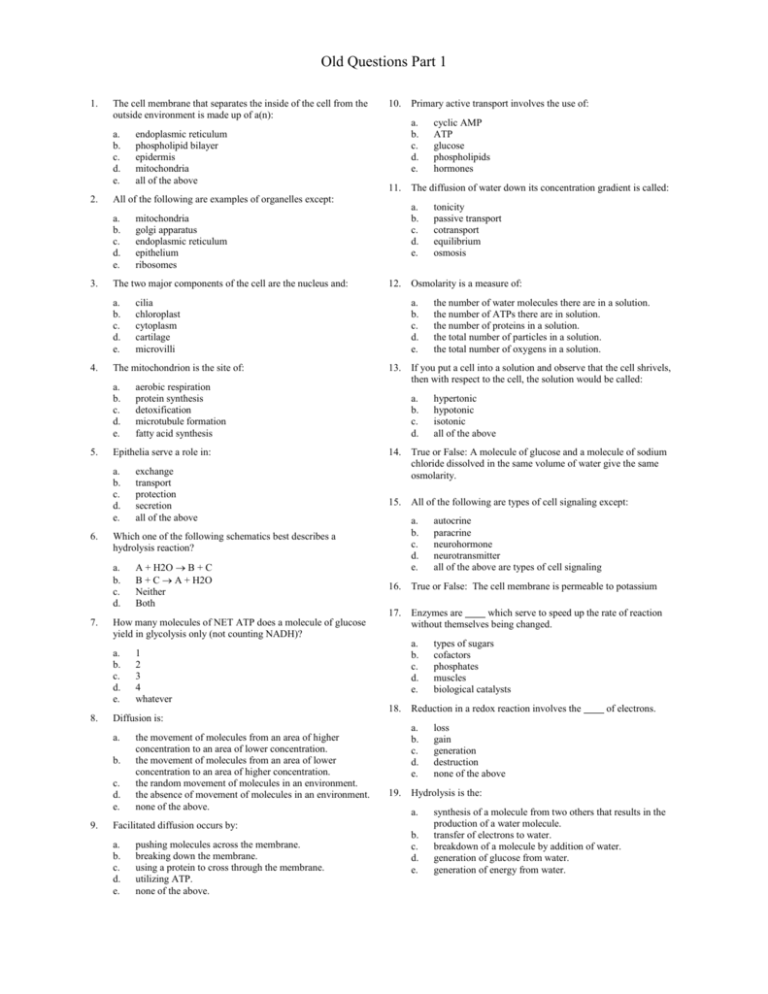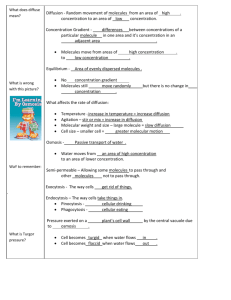1 - Molecular and Cell Biology
advertisement

Old Questions Part 1 1. The cell membrane that separates the inside of the cell from the outside environment is made up of a(n): a. b. c. d. e. 2. All of the following are examples of organelles except: a. b. c. d. e. 3. exchange transport protection secretion all of the above Which one of the following schematics best describes a hydrolysis reaction? a. b. c. d. 7. aerobic respiration protein synthesis detoxification microtubule formation fatty acid synthesis Epithelia serve a role in: a. b. c. d. e. 6. cilia chloroplast cytoplasm cartilage microvilli The mitochondrion is the site of: a. b. c. d. e. 5. mitochondria golgi apparatus endoplasmic reticulum epithelium ribosomes The two major components of the cell are the nucleus and: a. b. c. d. e. 4. endoplasmic reticulum phospholipid bilayer epidermis mitochondria all of the above A + H2O B + C B + C A + H2O Neither Both How many molecules of NET ATP does a molecule of glucose yield in glycolysis only (not counting NADH)? a. b. c. d. e. 1 2 3 4 whatever 10. Primary active transport involves the use of: a. b. c. d. e. cyclic AMP ATP glucose phospholipids hormones 11. The diffusion of water down its concentration gradient is called: a. b. c. d. e. tonicity passive transport cotransport equilibrium osmosis 12. Osmolarity is a measure of: a. b. c. d. e. the number of water molecules there are in a solution. the number of ATPs there are in solution. the number of proteins in a solution. the total number of particles in a solution. the total number of oxygens in a solution. 13. If you put a cell into a solution and observe that the cell shrivels, then with respect to the cell, the solution would be called: a. b. c. d. hypertonic hypotonic isotonic all of the above 14. True or False: A molecule of glucose and a molecule of sodium chloride dissolved in the same volume of water give the same osmolarity. 15. All of the following are types of cell signaling except: a. b. c. d. e. autocrine paracrine neurohormone neurotransmitter all of the above are types of cell signaling 16. True or False: The cell membrane is permeable to potassium 17. Enzymes are which serve to speed up the rate of reaction without themselves being changed. a. b. c. d. e. types of sugars cofactors phosphates muscles biological catalysts 18. Reduction in a redox reaction involves the 8. a. b. c. d. e. 9. of electrons. Diffusion is: the movement of molecules from an area of higher concentration to an area of lower concentration. the movement of molecules from an area of lower concentration to an area of higher concentration. the random movement of molecules in an environment. the absence of movement of molecules in an environment. none of the above. a. b. c. d. e. 19. Hydrolysis is the: a. Facilitated diffusion occurs by: a. b. c. d. e. pushing molecules across the membrane. breaking down the membrane. using a protein to cross through the membrane. utilizing ATP. none of the above. loss gain generation destruction none of the above b. c. d. e. synthesis of a molecule from two others that results in the production of a water molecule. transfer of electrons to water. breakdown of a molecule by addition of water. generation of glucose from water. generation of energy from water. Old Questions Part 1 20. The three steps in the catabolism (breakdown) of glucose are glycolysis, , and oxidative phosphorylation. a. b. c. d. e. anaerobic respiration glycogen production fatty acid production the citric acid cycle gluconeogenesis 21. The main form of storage of glucose in the body is: a. b. c. d. e. starch glycogen protein a lipid cholesterol 22. True or False: Passive and Active transport both require energy to take place. 23. All of the following are properties of diffusion EXCEPT: a. b. c. d. It is movement down a concentration gradient Rate of diffusion is inversely proportional to distance squared Inversely related to the size of the molecule under consideration All of the above are properties of diffusion 24. True or False: The sodium-glucose transporter is considered an antiporter. 25. An example of a secondary active transport would be: a. b. c. d. Na-K ATPase Na-Glucose transporter Both Don’t know 26. –70 mV is the a. b. c. d. e. of a cell. action potential graded potential resting membrane potential kinetic energy none of the above 27. Ions important in maintaining the membrane potential are: a. b. c. d. e. Na K Cl All of the above None of the above 28. Cell to cell communication occurs through the use of hormones, neurohormones, and: a. b. c. d. e. electrical signals water diacyl glycerol myelin sign language 29. Chemicals secreted by the cell that affect other cells are called: a. b. c. d. e. autocrines wastes drugs ions paracrines 30. An agonist is: a. b. c. d. e. a chemical that opposes a natural signal any chemical that mimics a natural signal a chemical that destroys a natural signal a chemical that is not involved in signaling none of the above








